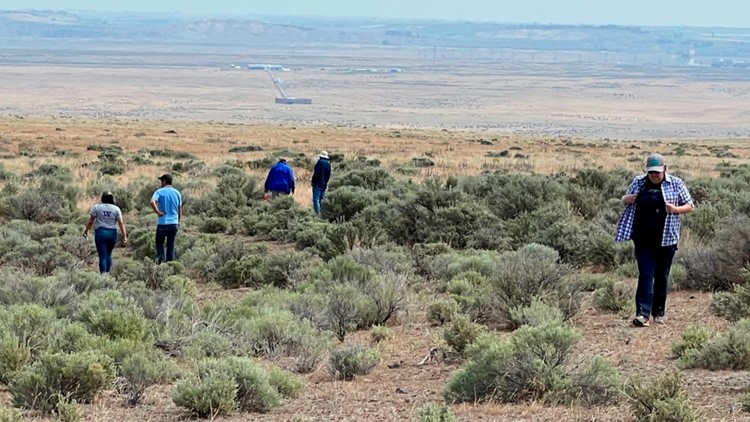RICHLAND, Wash. — Three federally recognized tribes have devoted decades to restoring the condition of their ancestral lands in southeastern Washington state to what they were before those lands became the most radioactively contaminated site in the nation's nuclear weapons complex, the Hanford Nuclear Reservation.
But the Yakama Nation, Confederated Tribes of the Umatilla Indian Reservation and Nez Perce Tribe have been left out of negotiations on a major decision affecting the future cleanup of millions of gallons of radioactive waste stored in underground tanks on the Hanford site near Richland.
In May, federal and state agencies reached an agreement that hasn't been released publicly but will likely involve milestone and deadline changes in the cleanup, according to a spokesperson for the Washington State Department of Ecology, a regulator for the site. As they privately draft their proposed changes, the tribes are bracing for a decision that could threaten their fundamental vision for the site.
“As original stewards of that area, we’ve always been taught to leave it better than you found it,” said Laurene Contreras, program administrator for the Yakama Nation’s Environmental Restoration/Waste Management program, which is responsible for the tribe's Hanford work. “And so that’s what we’re asking for.”
From World War II through the Cold War, Hanford produced more than two-thirds of the United States' plutonium for nuclear weapons, including the atomic bomb dropped on Nagasaki, Japan, in 1945. Production ceased in 1989, and the site’s mission shifted to cleaning up the chemical and radioactive waste left behind.
For these tribes, which have served as vital watchdogs in the cleanup process, the area’s history dates back long before Hanford, to pre-colonization. It was a place where some fished, hunted, gathered and lived. It’s home to culturally significant sites. And in 1855 treaties with the U.S. government in which the tribes ceded millions of acres of land, they were assured continued access.
The U.S. Department of Energy, the Environmental Protection Agency and the Washington State Department of Ecology have held confidential negotiations since 2020 on revising plans for the approximately 56 million gallons of radioactive waste stored in 177 underground tanks at Hanford. The discerning eyes of the tribal experts have been kept out, though EPA and Ecology have said there will eventually be opportunities for the tribes to meet with them about this.
The revisions are expected to affect an agreement among the three agencies that outlines the Hanford cleanup. Mason Murphy, program manager for the Confederated Tribes' Energy and Environmental Sciences program, points out that the tribes also weren't consulted in that original 1989 agreement.
“It’s an old scabbed-over wound,” Murphy said.
Currently, the agencies plan to convert high-level radioactive waste into glass form that would be sent to a deep geological repository, said Ecology Department spokesperson Ryan Miller. Low-level waste would be converted and disposed of permanently in stainless steel containers at a landfill at the Hanford site.
But there isn’t a deep geologic repository in the U.S. to dispose of the high-level waste, he said. And turning that waste into a glass form is reliant on a plant that hasn’t been completed and “faces ongoing technical challenges,” according to a U.S. Government Accountability Office report published last month.
Changes to plans to turn the high-level waste into a glass form could have wide-ranging consequences, said Dan Serres, conservation director for the environmental group Columbia Riverkeeper.
“There’s nothing that I’m aware of that demonstrates that another path is going to protect the Columbia River, or groundwater, or the interests of tribes (that) have a right to be using as much of this area as possible,” he said.
The tribes do have small teams of experts dedicated to the cleanup, and they've had an impact.
Through testimony to lawmakers in the 1980s, the Yakama Nation was instrumental in keeping the 580-square-mile (1,500-square-kilometer) site from becoming a deep repository where high-level nuclear waste from across the U.S. would be stored indefinitely.
More recently, tribal experts determined the U.S. Department of Energy's work to remove the radionuclide strontium from groundwater at Hanford would push it into the nearby Columbia River. Their findings prompted the federal agency to reconsider its plans, said Rose Ferri, project tracking resource analyst for Yakama Nation.
"It is important for someone to be that other level of review; to be like, ‘Does this really make sense? Are you really understanding the science here or was there a mistake made?’” said McClure Tosch, a natural resource injury assessment lead for the Yakama Nation.
Last week, experts from the tribe traveled to a Nike Missile site, which had been used to protect Hanford from enemy aircraft, to examine completed cleanup work and determine future restoration options.
The Nez Perce Tribe has four experts within its Environmental Restoration and Waste Management program, which handles much of its Hanford work. Program director Jack Bell said the team's hydrogeologist determined that Energy Department contractors underestimated to what extent a radioactive contaminant could travel into groundwater. The tribe sent letters to the agencies, and the model was updated.
“That model will be used over and over again,” Bell said.
The state Ecology Department said it plans to consult with the tribes once the draft agreement is more finalized. But when that will happen and in what form is still unclear. An energy department spokesperson said in a statement that while the tribes are not included in the negotiations, in other instances the department “consults with Tribal Nations when its action affects, or has the potential to affect, tribal rights or resources.” A regional EPA spokesperson said in a statement when the negotiations are completed, there will be opportunity for “tribal consultation and input ahead of public comment."
Tosch said every chance he gets, he brings up the Yakama Nation not being included in the negotiations.
“If there are permit decisions made, where there is a lot more on-site closure of waste, rather than what we assumed would have been all high-level waste that would have been treated and taken off site … that’s more land that will forever be a waste disposal facility,” he said. “That is very much against the direction and vision for tribal council.”



